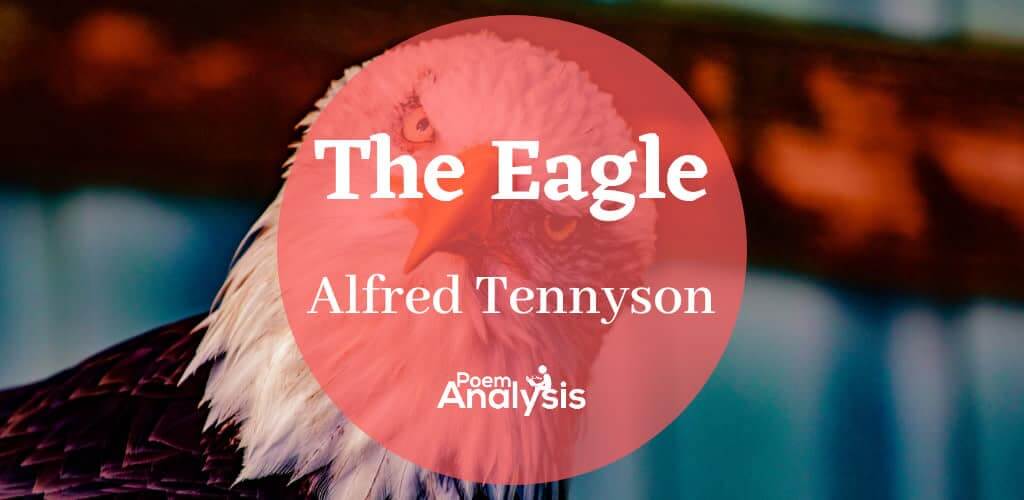‘The Eagle’ by Alfred Lord Tennyson portrays the swiftness and agility of the king of birds. The shortness of the poem is a reference to an eagle that is ready to latch onto its prey. It is like a monarch of nature, keeping a strategic distance from the metaphorical “wrinkled sea” crawling below. The poet is no doubt impressed by the bird’s agility and capacity. ‘The Eagle’ by Tennyson was a source of inspiration to Ted Hughes. He wrote ‘Hawk Roosting’ by imitating the Tennysonian model.
The Eagle Alfred Lord TennysonHe clasps the crag with crooked hands;Close to the sun in lonely lands,Ring'd with the azure world, he stands.The wrinkled sea beneath him crawls;He watches from his mountain walls,And like a thunderbolt he falls.
Summary
‘The Eagle’ by Alfred Lord Tennyson is a short two stanza poem that speaks on the power and solitude of a lone eagle on a rocky cliff.
The poem begins with the speaker describing how a solitary eagle is standing on the top of a craggy cliff. From where he is perched, with his “crooked hands” gripping the rocks, he can survey the whole “azure world” around and below him.
Tennyson’s eagle is in a real place of power and as soon as he is ready to, and not a moment sooner, he dives. In the final line, he makes his surprise move, barreling down toward the water in search of prey.
Structure
‘The Eagle’ by Alfred Lord Tennyson is a two stanza poem that is separated out into two sets of three lines, known as tercets. These tercets follow a very simple rhyme scheme that conforms to a pattern of AAA BBB. The poem also makes use of the metrical pattern of iambic tetrameter. This means that each line contains four sets of two beats, known as metrical feet (or iambs). The first is unstressed and the second stressed. It sounds something like da-DUM, da-DUM.
Poetic Techniques
Tennyson uses a number of poetic techniques within ‘The Eagle’. These include alliteration, caesura, and personification. The latter is perhaps the easiest to spot. It occurs when a poet imbues a non-human creature or object with human characteristics. In this case, the eagle is described as having “hands”. It is also referred to as “he” rather than “it,” therefore increasing its agency and individuality.
Another technique, alliteration, occurs when words are used in succession, or at least appear close together, and begin with the same letter. A great example is in the first stanza with the use and reuse of the letter “c”. Caesura is another interesting technique that involves splitting a line of verse in order to shift the emphasis. The last line of the first stanza, with the comma falling after “world” is an example.
Analysis of The Eagle
Stanza One
He clasps the crag with crooked hands;
Close to the sun in lonely lands,
Ring’d with the azure world, he stands.
This piece begins with a description of a creature, only labeled with the pronoun “He”. The speaker is assuming that a reader will understand who this “He” is, and if one reads the title of the poem it’s clear. Tennyson’s speaker is describing an eagle, who is at the moment the poem starts up on a “crag,” meaning a rugged, exposed cliff face.
This is somewhere human beings couldn’t, or would have trouble, reaching. There is something transcendent about this opening scene. It is beyond that which humanity can experience, except through the words of writers such as Tennyson. Alfred Lord Tennyson also makes use of alliteration in this first line in order to increase the rhythm of the phrase.
Additionally, through personification, Tennyson imbues the eagle with human-like features. He refers to its claws as “hands” and the whole eagle as “he” rather than “it”.
The simplicity of the rhyme in these lines carries the poem forward. It is contrasted by the dramatic images Tennyson has crafted. These only expand as he discusses the “lonely lands” that stretch out underneath the “crag”. This emphasizes the feeling of loneliness and isolation. As well as the fact that no human being can touch the place.
Tennyson expands the landscape further as he describes the ring of blue sky that wraps around “the…world”. The eagle stands as if lording, over the lands below him. He represents a clear image of power and knowledge, as well as the traditional meanings associated with eagles: freedom and bravery.
Stanza Two
The wrinkled sea beneath him crawls;
He watches from his mountain walls,
And like a thunderbolt he falls.
In the second stanza, the speaker gives the reader a few more details about the eagle’s surroundings. The rocky cliff on which the creature is perched is, as already made clear, very steep. Tennyson adds that it is also jutting out over the sea. The eagle is so high up, the sea appears to be covered in wrinkles. They represent the various shapes of the waves and might make one consider how age and time play into this description.
In the next line, the eagle’s position of power on the rocks is reemphasized. He is high above everything else and is able to “watch” what’s going on below and around him. A reader should also take note of how Tennyson called the mountain walls the eagle’s walls as if they belong to him. He has a claim over this piece of land and because he is the only creature capable of reaching it, there is no one to challenge him.
The transition from the second line to the third is powerful. All of a sudden the eagle drops from his perch, plunging toward the sea below. This intentional dive was preplanned on the eagle’s part, certainly, but for the reader, it comes as something of a shock. “He” is hunting a smaller creature below him and knows when the precise moment would be for him to dive for it. In the final line, Tennyson describes the eagle as a “thunderbolt”. Again, this speaks to his god-like power in this world and might even inspire a direct comparison to the god Zeus.





barbeque bacon burger
I could go for that right now…
hamburger
You are better with cheese. 😉